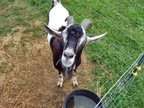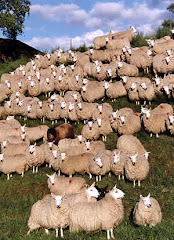While it is true that you can profit from goat –keeping, but caring for goats also means making sure that they are in good health and in the best shape.
Especially for goat herders who either make a living out of keeping goats for producing milk and dairy products, meat, mohair or cashmere, or simply breeding goats for sale, there are things to look out for to know if your goats are in tip top shape or needs medical attention.
Goat herders must be ever vigilant in watching out for signs that will indicate if their goats are in need of medical attention or lack nutrition that they need.
Here are some signs that herders need to look out for.
1. Look for goats that usually fall behind or are well away from the main herd, most especially when goats are being herded together and shows signs of not eating, having an abnormal body posture such as a head hanging down, or even gets separated during herding since these are tell tale signs that something could be wrong. Goats usually separate themselves when they could be suffering from an illness or are pregnant.
2. Always make sure to observe the feces or droppings, if the droppings clump together, scouring (diarrhea) or the droppings are very hard, then something may be wrong. Visit a local veterinarian to see what needs to be done or what needs to be administered.
3. Look at the herd to see if there are goats that lag behind or have problems keeping up with the herd, since these can also show signs of a health problem afflicting the animal. These are usually signs of nutrition deficiency, parasite infestation or contracted a disease.
4. Aside from body signs, you may also need to observe the goats’ feet and legs for signs of swelling may even manifest limping or dragging of the legs and feet.
5. A sudden or inexplicable weight loss in animals, can also be a sign of deteriorating health that affects the goat’s health.
6. Another tip is to also look for signs of swelling underneath the chin, which can be indicative of internal parasites in the stomach or intestines, or an abnormal-sized throat which may be signs of goiter.
7. Another tell tale sign is an abnormal gait that could be limping, staggering or abnormal walking that may indicate tetanus. This could be due to a wound that became infected or has started to contaminate the goat’s blood with the wound infection. This is treatable at an early stage so make sure to have wounds treated with iodine to disinfect the wound with hydrogen peroxide or iodine and prevent it from getting contaminated to avoid infection.
8. A dull or rough coat may indicate underlying disease or deficiencies, which may need immediate attention by a veterinarian
Lastly, look for abnormal discharges especially blood, pus or mucus from the mouth, eyes, ears or vulva, or any other part of the goat’s body, an internal infection can be very dangerous and allows for the rapid deterioration of the goat’s health.
Now you see the importance that caring for goats also means making sure that they are in good health and in the best shape.
Selengkapnya...
Wednesday, September 22, 2010
Caring for Goats also Means Making Sure That They Stay Healthly
Thursday, September 9, 2010
Met Lebaran Chevioters
Lihat Kartu Ucapan Lainnya
(KapanLagi.com)
Selengkapnya...
Friday, September 3, 2010
Basic Goat Care Ideas That Many May Not be Aware About

Goat keeping or goat farming is not actually rocket science, and there are indeed basic goat care ideas that many may not be aware about.
In fact, basic goat care is actually pretty simple, sometimes trivial, but never too tricky or tedious…all it needs is practical know –how and common sense.
First and foremost, if you happen to supplement grass feeding with mineral or nutrient infused feeds, always read the label and never – ever – feed sheep feed to goats, same goes the other way around.
Sheep and goats are entirely different animal species, with entirely different characteristics, nutritional requirements and environmental needs.
Never feed bucks or wethers with grain products, which in raw form cannot be tolerated by their metabolism, but if you feel and see that the your bucks require supplementation, make sure to consult a veterinarian, who would recommend grain pellet feed specifically for bucks. Although grain products are good for does, it works otherwise for bucks.
Dry oatmeal is also a good choice, but should only be taken in moderation.
Goats, like dogs, love treats with a bit of variation like fallen tree branches, especially aromatic ones, grapes, raisins, bread, soda crackers and their favorite - animal crackers.But make sure not to overdo giving treats since it can be dangerous to their health.
Always make sure to feed fresh and nutritious hay - with or without alfalfa – as needed. Fresh hay or grass is also loaded with natural minerals and nutrients that can help prevent diseases.
Do not forget to provide clean water and fresh water in a clean bucket, which during winter, should also be ice free.
You may also want to have loose minerals or mineral block available at all times and accessible to your goats. Salt can also be made available in a separate feeding dish or as a feeding block.
For does, also make sure to have a well balanced grain product handy at all times. It gives does added nutrients & minerals needed to stay healthy and helps in having healthy offspring.
It is easy to feed your does with grain, so always watch your animal’s condition to determine how much or how little they may need. Same way with supplementing lactating does with more protein, since this is important in their milk for young kids.
Be reminded that hoof trimming is necessary every 4 to 6 weeks, to keep your animal from developing hoof rot or leg and hoof issues.
Have your goats vaccinated annually with tetanus shots, as well as Bo-Se and Copper supplements as needed.
Here’s another funny yet important fact, to make sure that every goat comes running during feed time, otherwise, something may be wrong.
Another tip at watching your goat’s condition is to check their coat. A coarse, dull, or thin coat can give you many clues from stomach or intestine parasites to nutrient deficiency.
Finally, look for signs of legs bowing (back or inward), since this can indicate a nutrient deficiency.
These are but some of the basic goat care ideas that many may not be aware about, but will surely be of good help in caring for your goats and knowing what signs to look out for.
Selengkapnya...






